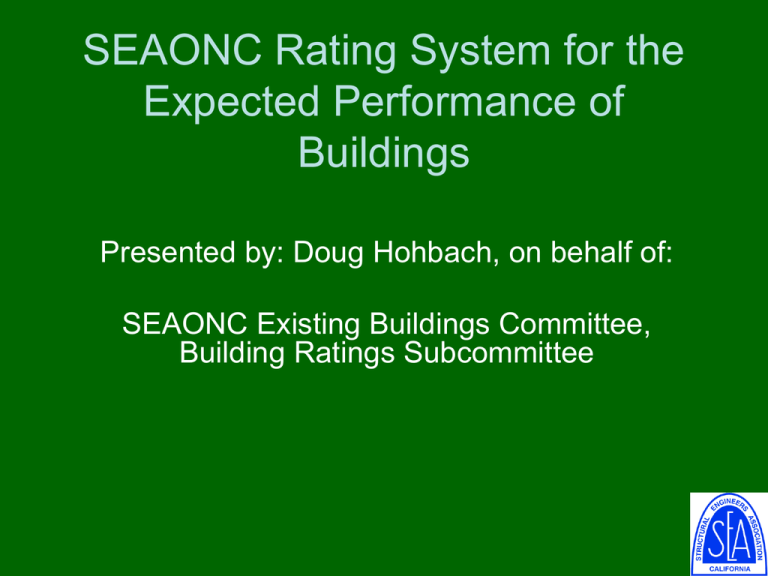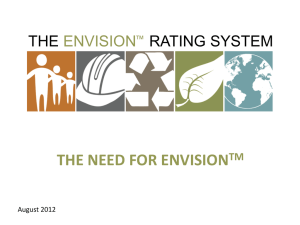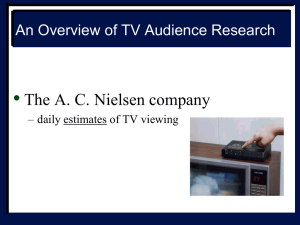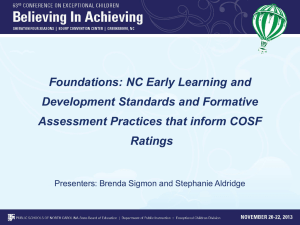SEAONC Rating System for the Expected
advertisement

SEAONC Rating System for the Expected Performance of Buildings Presented by: Doug Hohbach, on behalf of: SEAONC Existing Buildings Committee, Building Ratings Subcommittee SEAONC Building Ratings Subcommittee Members Marguerite Bello, Mathew Bittleston, Stephen Bono, David Bonowitz, Craig Cole, David McCormick, Evan Reis, Kate Stillwell Co-Chairs: Ron Mayes, Doug Hohbach Seismic Ratings Goal: Reducing Seismic Risk • Intent is to provide reliable seismic risk information in accessible form to general public • Utilize existing evaluation methodologies Introduction • SEAONC Existing Buildings Committee – tasked by SEAONC Board August 2006 • Phase 1 – Feasibility – October 2006 to June 2008 • Phase 2 – Development – July 2008 to September 2011 • ATC stakeholder workshop – March 2011 The Problem: Tenant: Office Lease Information Provided: • “Designed to Code” • Level 1 PML: 18% • Class A office space Information for Decisions: • Will employees be injured? • Will our data be secure? • How long until we can serve our clients? • Might the landlord breach contract? (repair costs > liquid funds) The Problem: Condo Buyer Information Provided: • “Not a landslide zone” • “Not a liquefaction zone” • “Not a fault zone” Information for Decisions: • Will I be safe? • Will I be able to keep living here? • Will I be able to retrieve my possessions? My car? • Should I buy EQ insurance? The Problem: Owner: Emergency Plan Information Provided: • ASCE 31: “Meets LS” Information for Decisions: • What will happen to systems? • How much required cash after the event? • How much operational downtime? Objective of an Earthquake Performance Rating System • Communicate seismic risk to nonengineers – Intended audience: anyone who makes decisions about buildings • Ultimate objective: spur action to reduce seismic risk in building stock Definition of an Earthquake Performance Rating System • Set of definitions, rules, and procedures that lead to a concise characterization of earthquake performance Existing Earthquake Performance Rating Systems • ASCE 31 – Output not straightforward to interpret by general public – Does not readily allow comparisons between buildings – Not generally adopted by private sector Existing Earthquake Performance Rating Systems • Probable Maximum Loss Analyses (PMLs) – Life safety not directly addressed – Lower level of understanding and effort can result in higher rating – Misleading degree of precision implied Generating a Rating Context Outputs of (E) Evaluations Development: Phase 2 Assignment Procedure Rating Context - ATC 71-2 Workshop • Workshop on a Rating System for the Earthquake Performance of Buildings • Feedback from building owners, investors, policy-makers regarding utility of an EPRS • Funded by FEMA ATC 71-2 Workshop Consensus: Hazard Level • Make analogous to current seismic codes ATC 71-2 Workshop Consensus: Mandatory vs. Voluntary • Consensus: rating system should begin as voluntary not mandatory ATC 71-2 Workshop Consensus: Rating Symbols • Symbolic system preferred to point scale • Avoid misperception of undue precision ATC 71-2 Workshop Consensus: Scope and Cost of a Rating • Use separate system for small scale residential buildings and commercial buildings ATC 71-2 Workshop Consensus: Qualifications / Quality Control • Who should produce ratings? – Certified and licensed engineer for commercial buildings – Certified and credentialed individual acceptable for small scale residential buildings • Independent oversight necessary ATC 71-2 Workshop Consensus: Rating Dimensions • Report 3 Dimensions – Safety – Repair Cost – Time to Regain Function • Potentially combine into one rating for presentation ATC 71-2 Workshop • Workshop on a Rating System for the Earthquake Performance of Buildings • Feedback from building owners, investors, policy-makers regarding utility of an EPRS • Funded by FEMA • Proceedings of ATC 71-2 available now at ATC booth here at the convention Context Summary: Private Transactions Impetus: Voluntary, Mandatory, or Triggered? Generated by: Owner (or agent) or 3rd Party? Results: Private or Public? Verification: Self-enforcing or 3rd party? Overall criteria: Feasible and Achievable Earthquake Performance Rating System Development • Two main steps – Defining each rating value – Establishing a procedure by which to derive the rating value EPRS Development • Design rating system for use in California – Also could be applicable to other areas of high and moderate seismicity Attributes of a SEAONC Rating • Three Independent Dimensions Safety Repair Cost Time to Regain Function • • • • Clear and concise for a general audience Basis of comparison: no predictions No new tools Contents excluded (if movable) SEAONC Definitions for Rating Values: Safety Rating Safety Building performance would not lead to conditions commonly associated with earthquake-related entrapment. Building performance would not lead to conditions commonly associated with earthquake-related injuries. Building performance would not lead to conditions commonly associated with earthquake-related death. Building performance in select locations within or adjacent to the building leads to conditions known to be associated with earthquake-related death. Performance of the building as a whole leads to conditions known to be associated with earthquake-related death. SEAONC Definitions: Safety Rating Safety Rating Definition No entrapment No injuries No death Death in isolated locations Death in multiple or widespread locations Definitions and Commentary for Each Rating Value: Safety • Direct language utilized for clear communication • To exceed safety rating, knowledge of additional factors (falling hazards, factors affecting egress) is necessary typically excluded from a conventional structural evaluation SEAONC Definitions for Rating Values: Repair Cost Rating Repair Cost Building performance would lead to conditions requiring earthquake-related repairs commonly costing less than 5% of building replacement value. Building performance would lead to conditions requiring earthquake-related repairs commonly costing less than 10% of building replacement value. Building performance would lead to conditions requiring earthquake-related repairs commonly costing less than 20% of building replacement value. Building performance would lead to conditions requiring earthquake-related repairs commonly costing less than 50% of building replacement value. Building performance would lead to conditions requiring earthquake-related repairs costing more than 50% of building replacement value. SEAONC Definitions: Repair Cost Rating Repair Cost Within Typical Operating Budget Building performance would lead to conditions requiring earthquake-related repairs costing less than 5% of building replacement value. Within Typical Insurance Deductible <10% of building replacement value Within Industry SEL Limit <20% of building replacement value Repairable Damage <50% of building replacement value Substantial Damage >50% of building replacement value SEAONC Definitions for Rating Values: Time to Regain Function Rating Time to Regain Function Building performance would support the building’s basic intended functions within hours following the earthquake. Building performance would support the building’s basic intended functions within days following the earthquake. Building performance would support the building’s basic intended functions within weeks following the earthquake. Building performance would support the building’s basic intended functions within months following the earthquake. Building performance would support the building’s basic intended functions within years following the earthquake. SEAONC Definitions: Time to Regain Function Rating Time to Regain Function Within hours Within days Within weeks Within months Within years Definitions and Commentary for Each Rating Value: Time to Regain Function • Since impractical to set precise boundaries to categories, categories are purposefully approximate • Corresponds to time it takes before building is substantially functional, excluding externalities that may affect a building’s functionality Definitions and Commentary for Each Rating Value • Ratings are quantitative (to degree that methodology allows) and predictive (try to convey real world meaning) – Safety: akin to using performance-based terminology – Repair Cost: aligns rating categories with industrystandard decision points – Time to Regain Function: no strong precedents exist, approximate categories are defined • Ratings include nonstructural features, but exclude performance of typical contents Rating Determination • EPRS not an evaluation tool – Translates evaluation results into consistent and pragmatic terms • EPRS does not introduce new evaluation criteria, but relies on the criteria of underlying methodology ASCE 31 Evaluation • Rating system provides a procedure for producing a rating from ASCE 31 (structural, non-structural, geotechnical evaluation statements) • Ratings for Safety, Repair Cost, Time to Regain Function can be derived from ASCE 31 evaluation – Tier 1, Tier 2, or Tier 3 evaluation may be performed – Rating may change as more analysis is performed ASCE 31 Evaluation • Tier 1 - Screening Phase (Checklists) • Tier 2 – Evaluation Phase (Full Building or Deficiency Only) • Tier 3 – Detailed Evaluation (ASCE 41) Generating a Rating Outputs of ASCE 31 Evaluations Assignment Procedure Rating Mapping ASCE 31 Evaluation to a Safety Rating Structural Performan ce2 Nonstructu ral Performan ce Geotechnic al Performan ce3 Rating Not Achievable IO selection IO IO LS LS4 LS LS selection S3 LS4 LS selection S2 LS selection S2 LS selection S2 Less than LS selection S2 Safety Rating Definition No entrapment. No injuries. No death. Death in isolated locations. Death in multiple or widespread locations. Rating 1 Structural, Nonstructural, and Geotechnical levels of performance must be satisfied to achieve rating. “Selection” indicates that some of the ASCE 31 criteria need not be met; the selection will be defined in the SEAONC rating instructions. Selection “S3,” for example, indicates the particular selection of ASCE 31 issues required for a 3-star safety rating. 2 Includes performance of foundations 3 Refers to items from the Geologic Site Hazards Checklist (i.e. liquefaction, slope failure, and surface fault rupture) 4 Need not comply with liquefaction evaluation statement Mapping ASCE 31 Evaluation to a Repair Cost Rating Structural Performan ce2 Nonstructu ral Performan ce Geotechnic al Performan ce3 Repair Cost Rating Definition Within Typical Operating Budget. Rating Rating Not Achievable Rating Not Achievable IO Rating Not Achievable Within Typical Insurance Deductible. Within Industry SEL limit. IO LS IO LS IO Repairable Damage. Substantial Damage. LS Less than LS 1 Structural, Nonstructural, and Geotechnical levels of performance must be satisfied to achieve rating. 2 Includes performance of foundations 3 Refers to items from the Geologic Site Hazards Checklist (i.e. liquefaction, slope failure, and surface fault rupture) Mapping ASCE 31 Evaluation to a Time to Regain Function Rating Structural Performan ce2 Nonstructu ral Performan ce Geotechnic al Performan ce3 Rating Not Achievable IO IO selection F4 IO IO selection F3 IO selection F3 LS LS selection F2 LS LS Less than LS selection F2 Less than LS Less than LS Time to Regain Function Rating Definition Rating Within Hours. . Within Days. Within Weeks. Within Months. . Within Years. 1 Structural, Nonstructural, and Geotechnical levels of performance must be satisfied to achieve rating. “Selection” indicates that some of the ASCE 31 criteria need not be met; the selection will be defined in the SEAONC rating instructions. Selection “F3,” for example, indicates the particular selection of ASCE 31 issues required for a 3-star functionality rating. 2 Includes performance of foundations. 3 Refers to items from the Geologic Site Hazards Checklist (i.e. liquefaction, slope failure, and surface fault rupture). ASCE 31 Evaluation • Most effective approach to mapping ASCE 31 evaluation statements is to consider the damage and performance they generally suggest (not the worst or extreme case) – Duty of engineer/qualified person to understand interaction of non-compliant evaluation items and resolve them into a rating Demand for Seismic Ratings Top Developers: Owners of new buildings should End want a rating for marketing purposes. They Ratings have spent money to meet current seismic standards and they are leasing against older buildings that do not measure up. Major Tenants: Major tenants want information on down-time as well as risks to life and contents. Governments and Institutions: Use ratings to reassure the electorate that funds are being well spent and employees that buildings are safe. Demand for Seismic Ratings Mid Range Ratings Lenders and Tenants: Lenders and tenants will welcome this information as they make go/no go decisions Demand for Seismic Ratings Low End Ratings Cities and States: Governing bodies could mandate ratings be obtained and disclosed for known classes of vulnerable or dangerous buildings. (A rating system designed for voluntary private use might need to be modified for application in these mandatory public contexts.) Rating Validation • Critically important to maintain high level of technical credibility • Vision: independent non-profit organizations established by others to provide peer review and technical consistency – Accredit engineers to market and apply the SEAONC rating system – Example: LEED and its adoption by USGBC Rating Validation • SEAONC not expected to directly participate in review or accreditation – May review an application developed by nonprofit to ensure that it follows SEAONC intent – Assures that independent organization claiming to use SEAONC rating system adheres to the established process • In the future, may establish accreditation requirements for engineers and develop minimum peer review standards Example Application: Steel Braced Frame Office Building ASCE 31 Analysis • Structural - LS (some queries required Tier 2 analysis) • Non-structural - LS with limited exceptions • Geotechnical - LS Rating: Safety Repair Cost Time to Re-Occupy Performance Level Mapping: ASCE-31 Performance Level Life Safety Immediate Occupancy Rating Values: Safety Repair Cost Time to Regain Function Safety Repair Cost Time to Regain Function Earthquake Performance Rating • SEAONC Earthquake Performance Rating System – Safety – Repair Cost – Time to Regain Function SEAONC EPRS – Ready to Reduce Seismic Risk • • • • Multiple dimensions Clear differentiations between ratings Utilizes existing evaluation methodology Higher ratings require more understanding – ignorance not rewarded • Ratings readily comparable Status • Methodology to obtain earthquake performance ratings utilizing ASCE 31 has been completed • Next step: publication of evaluation statements for ratings, along with application examples “Beta testing” • Longer term: include mapping of other existing or new evaluation standards to ratings Thanks SEAONC Existing Buildings Committee – Building Ratings Subcommittee









